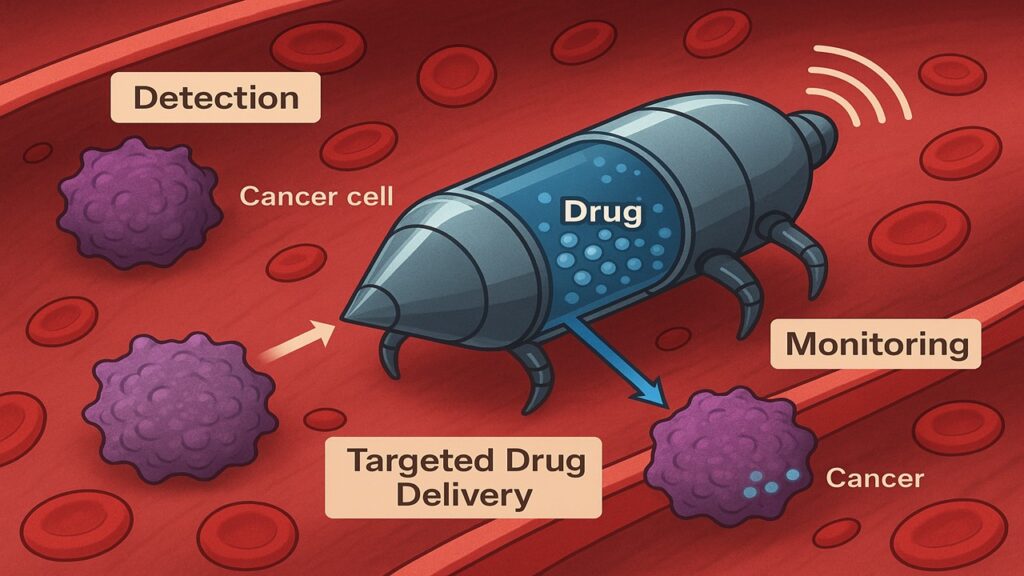
हिंदी में पढ़ने के लिए मेनू बार से हिंदी भाषा चयन करें।
A Tiny Robot That Could Save Lives
Imagine a robot so small that it can travel through your blood, find cancer cells, and deliver medicine only to the diseased part—without harming the healthy cells. Sounds futuristic, right? But this is becoming reality through Nano-Robot Technology.
These tiny robots, called nano-robots, are thousands of times smaller than a human hair. They are specially designed to detect cancer early and deliver medicines precisely, reducing side effects and improving recovery chances.
What is Nano-Robot Technology?
Nano-Robots (or Nanobots) are microscopic robots that are 1 to 100 nanometers in size.
(1 nanometer = one billionth of a meter)
Their main role in healthcare is to:
- Detect cancer cells inside the body
- Deliver medicine only to affected areas
- Protect healthy tissues from harmful drugs
These nano-robots are made using advanced materials and often contain tiny sensors, medicine reservoirs, and navigation systems.
How Does This Technology Work?
Nano-Robots follow a smart step-by-step process:

1. Detection
They are injected into the bloodstream and travel throughout the body.
They are programmed to identify cancer cells based on their unique shape, behavior, or protein markers.
2. Targeted Drug Delivery
Once the cancer cell is found, the robot releases the drug directly at that spot.
This reduces damage to other healthy cells and increases the effectiveness of the treatment.
3. Real-Time Monitoring
Some nano-robots are also equipped to send back data to doctors, helping them monitor the progress and response of the treatment.
🌍 Which Countries and Companies Are Working on It?
🇺🇸 United States
- MIT (Massachusetts Institute of Technology) – a leader in nano-medicine research
- Caltech – developing DNA-based nano-robots
- Google Health & IBM – exploring AI-powered nano-medicine
🇮🇳 India
- IIT Delhi & IIT Bombay – working on nano-drug delivery systems
- Tata Memorial Centre – using nano-particles in cancer treatment research
🇮🇱 Israel
- Technion Institute – successfully developed nano-robots for targeting cancer cells
🌏 Other Countries
Japan, Germany, and China are investing heavily in nano-medical technologies
Key Features of Nano-Robots
| Feature | Description |
| 🎯 Targeted Treatment | Delivers medicine directly to cancer cells only |
| 🛡️ Safe for Healthy Cells | Reduces side effects and damage to other tissues |
| 💊 Less Medicine Needed | Small doses become more effective |
| 🧭 Smart Navigation | Moves inside the body like a GPS-guided tool |
| ⚠️ Early Detection | Helps catch cancer in early stages |
Challenges in Nano-Robot Technology
Despite the promise, some challenges remain:
- High Cost – Creating nano-robots is expensive
- Navigation Control – Hard to guide them precisely in complex human systems
- Long-Term Safety – More studies are needed to ensure no long-term harm
- Limited Availability – Currently used only in research or early trials
What’s the Future?
- Nano-Robots may treat other diseases like Alzheimer’s, diabetes, and blocked arteries
- We could see personalized nano-robots, designed specifically for each patient
- In the future, nano-robots may also do real-time health monitoring, like a scanner inside your body
A Ray of Hope
Nano-Robot Technology is one of the most exciting innovations in the medical field.
It gives us new hope in fighting cancer with precision, less pain, and better results.
While it’s not yet available for everyone, rapid progress is being made.
As costs go down and safety improves, this technology could change how we treat many diseases—not just cancer.
👉 Until then, it’s a symbol of hope and possibility for a future where medicine is smart, targeted, and painless.

































































